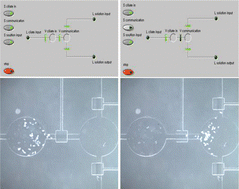In this study, we introduce a microfluidic device equipped with pneumatically actuated valves, generating a linear gradient of chemoeffectors to quantify the chemotactic response of Tetrahymena pyriformis, a freshwater ciliate. The microfluidic device was fabricated from an elastomer, poly(dimethylsiloxane) (PDMS), using multi-layer soft lithography. The components of the device include electronically controlled pneumatic microvalves, microchannels and microchambers. The linear gradient of the chemoeffectors was established by releasing a chemical from a ciliate-free microchamber into a microchamber containing the ciliate. The ciliate showed chemotactic behaviours by either swimming toward or avoiding the gradient. By counting the number of ciliates residing in each microchamber, we obtained a precise time–response curve. The ciliates in the microfluidic device were sensitive enough to be attracted to 10 pmol glycine-proline, which indicates a 105 increase in the ciliate's known sensitivity. With the use of blockers, such as DL-2-amino-5-phosphonopentanoic acid (APPA) or lanthanum chloride (LaCl3), we have demonstrated that the NMDA (N-methyl-D-aspartate) receptor plays a critical role in the perception of chemoeffectors, whereas the Ca2+ channel is related to the motility of the ciliate. These results demonstrate that our microfluidic chemotaxis assay system is useful not only for the study of ciliate chemotaxis but also for a better understanding of the signal transduction mechanism on their receptors.

You have access to this article
 Please wait while we load your content...
Something went wrong. Try again?
Please wait while we load your content...
Something went wrong. Try again?


 Please wait while we load your content...
Please wait while we load your content...